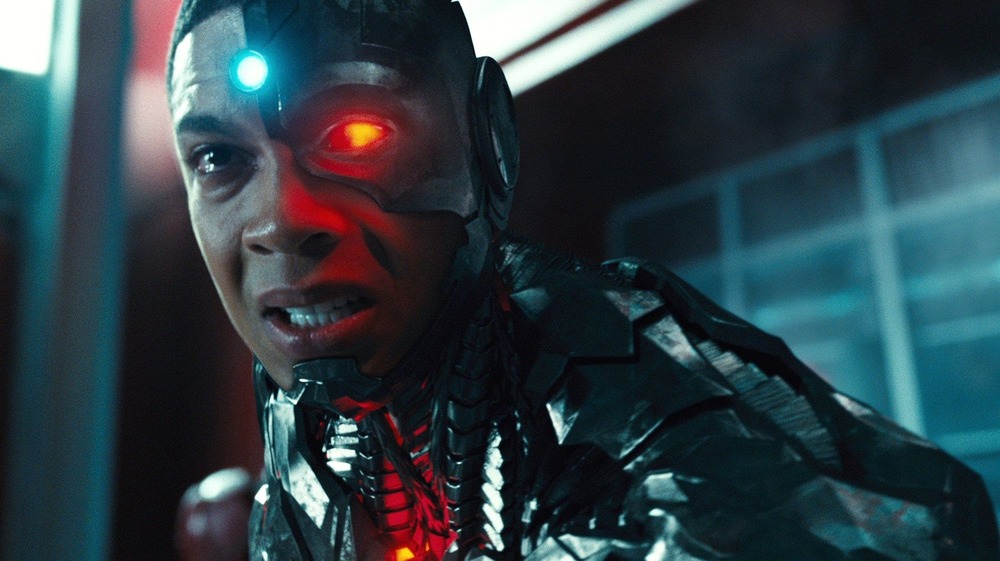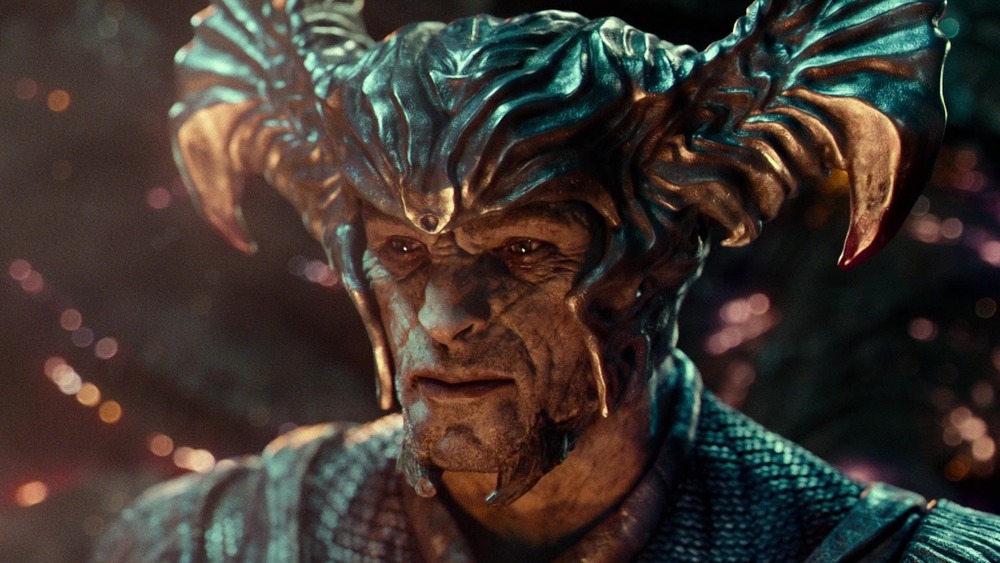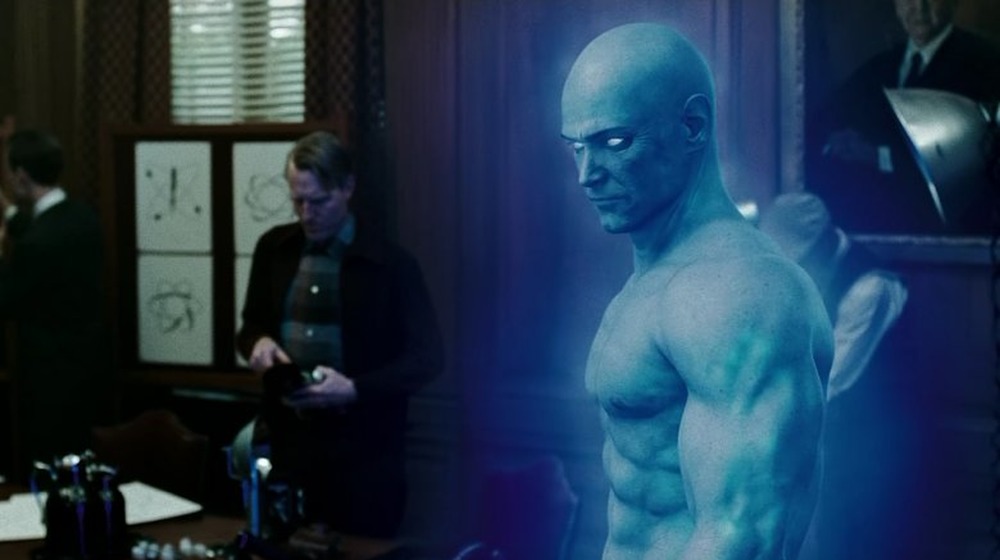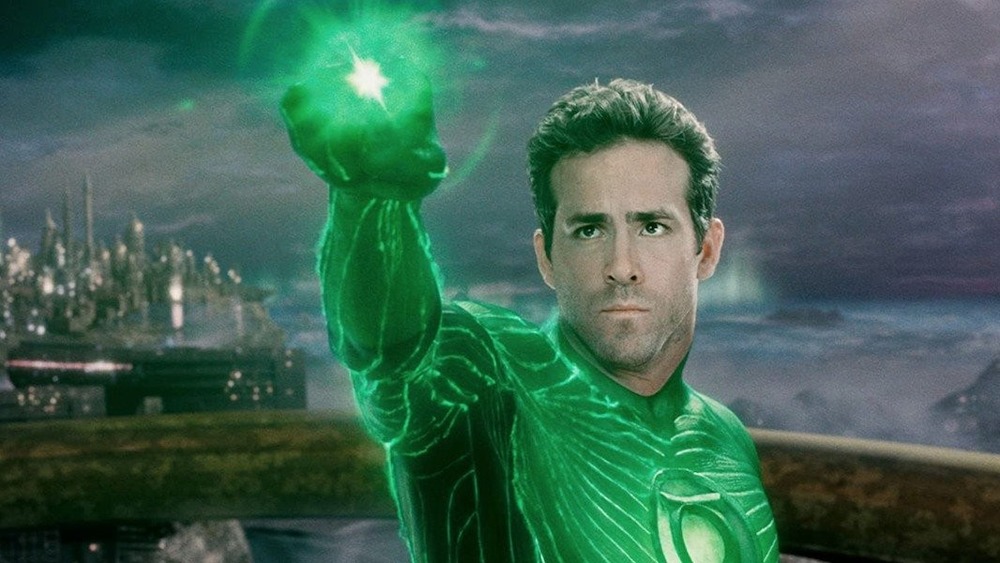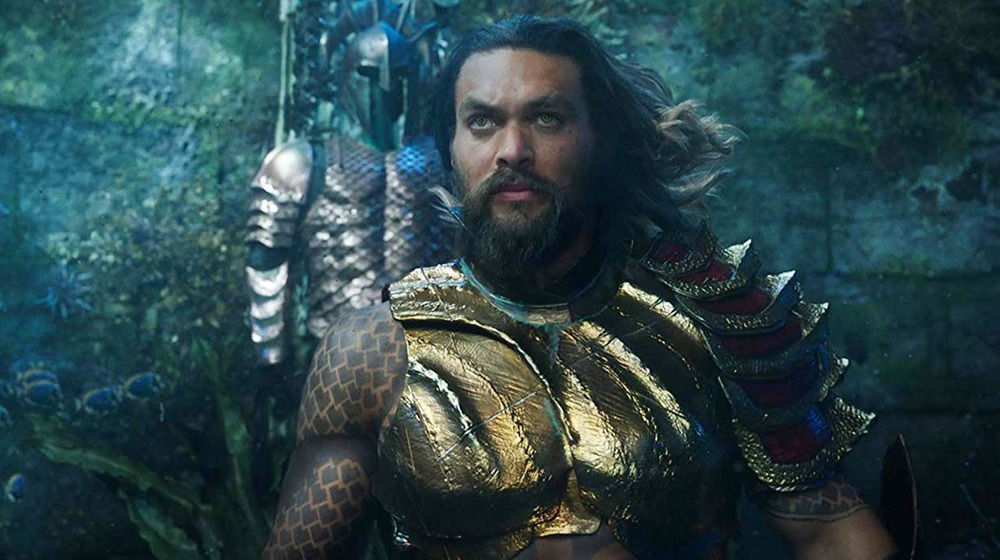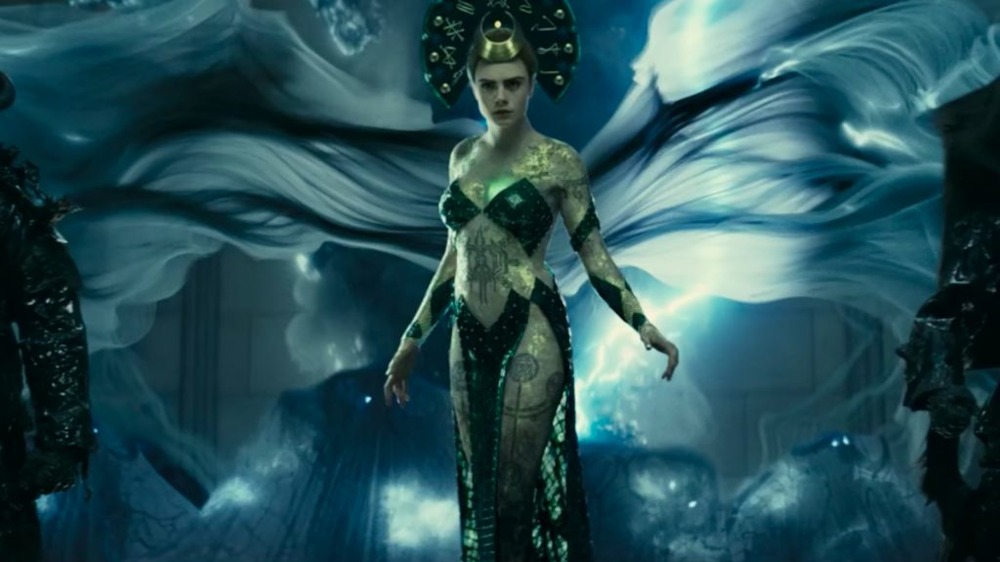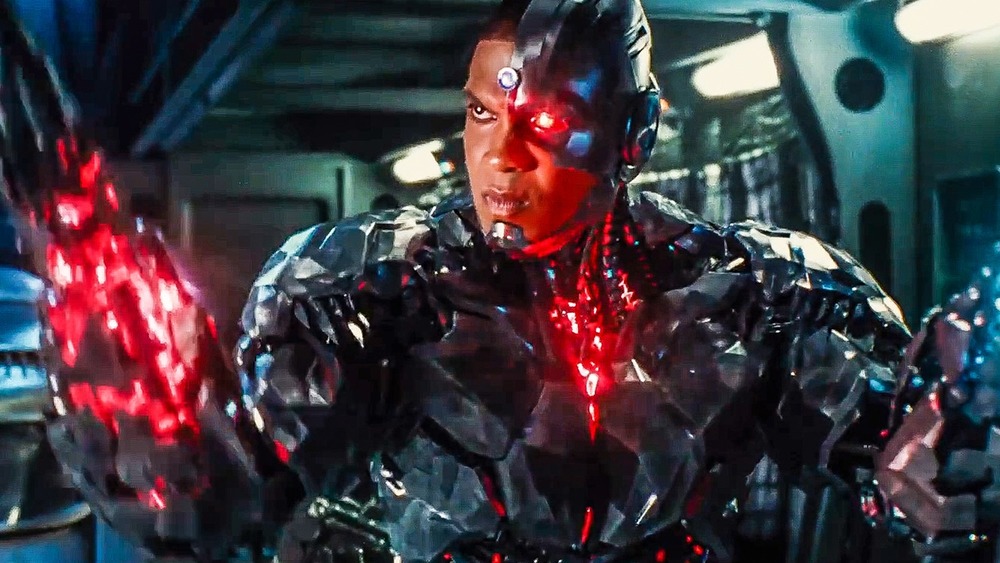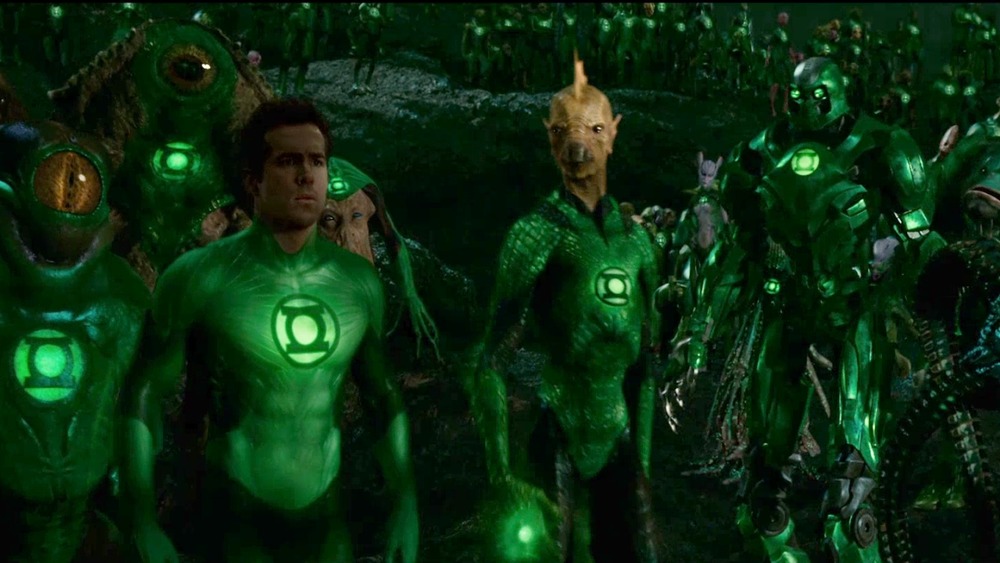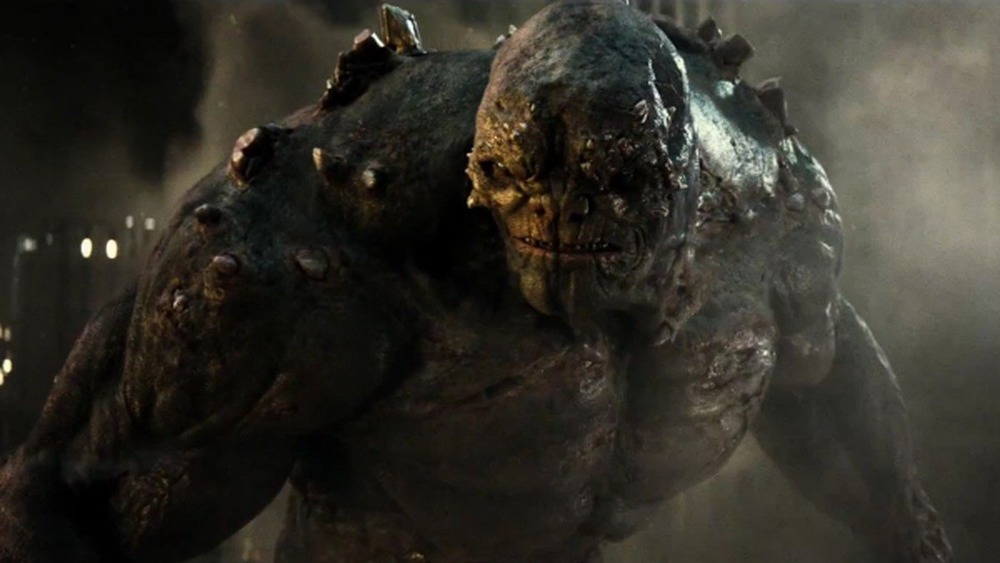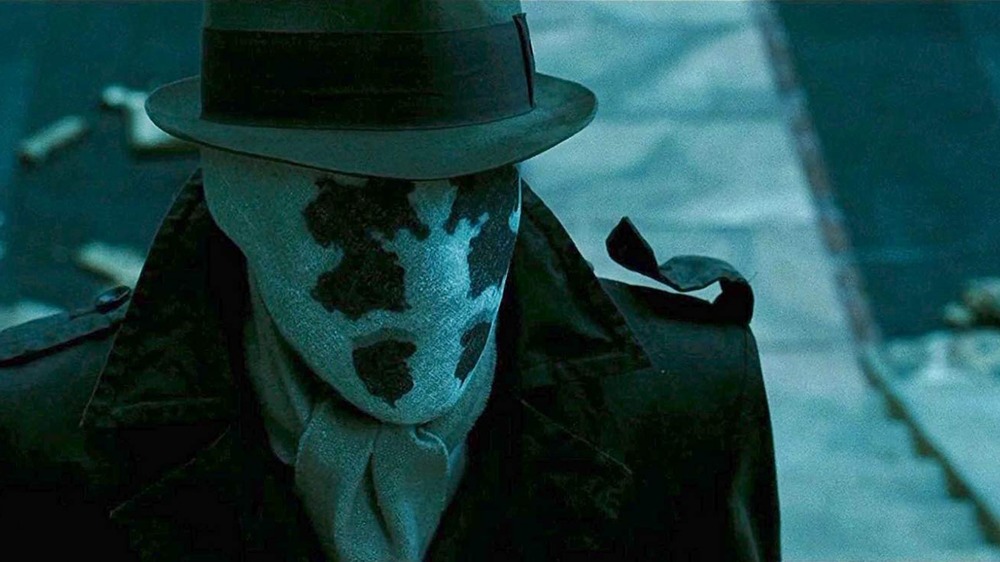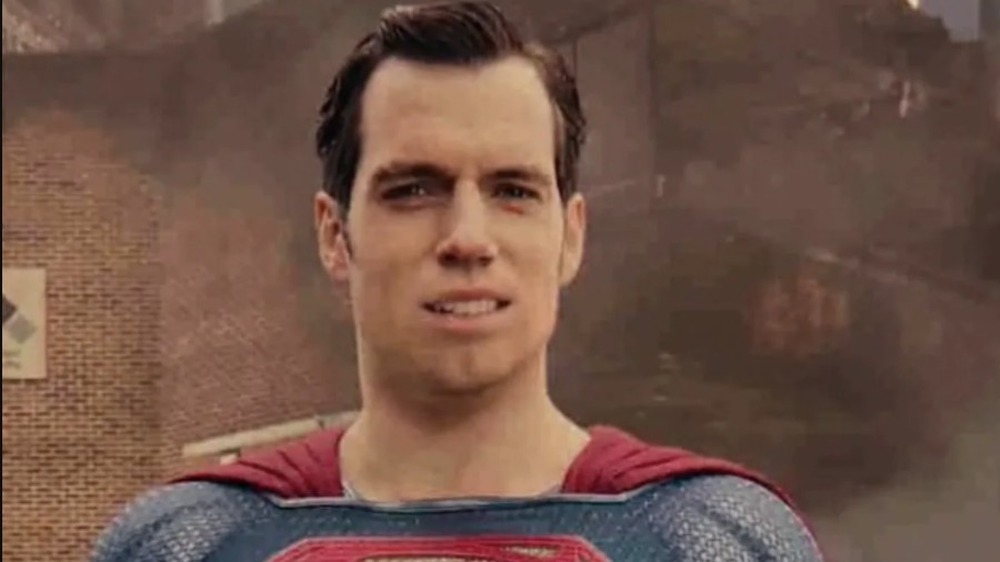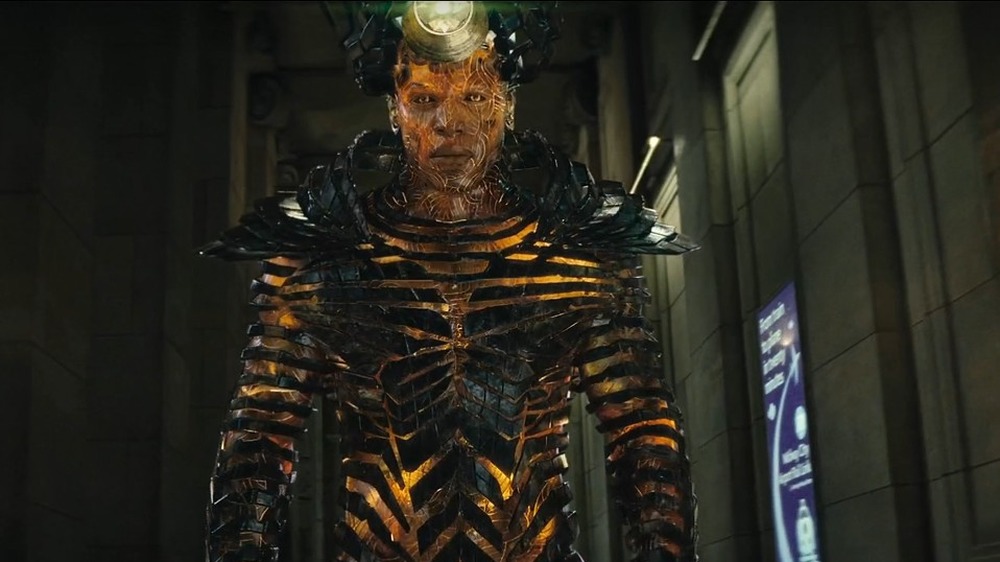These DC Actors Needed To Be Digitally Enhanced For Their Roles
Based on the adventures DC Comics writers and artists have been forging for decades, the world of DC's cinematic adaptations includes cybernetic do-gooders, gods, monsters, aquatic monarchs, intergalactic peacekeepers, and more kinds of fantastic creatures than we have room to name here. A world like that needs some of the cutting edge technology on display in blockbuster films to be realized. That's likely to be the case as long as the number of Kryptonians and otherworldly sorceresses showing up for Hollywood casting calls remains relatively low.
But not all digital enhancements are created equal. Much of the digital imaging work we've seen on display in Warner Bros' DC films has helped incredible heroes and villains come to life, while some of it has become the subject of mockery or controversy.
Whether they made beings of our wildest imaginations seem utterly real or made us wonder why they bothered, here are actors from DC's films who needed to be digitally enhanced for their roles.
Steppenwolf may have been a rushed job in Justice League
When DC's most popular heroes assembled for 2017's Justice League, the finished product wasn't well received. One of the more consistent criticisms leveled against the film was the CGI used to create Steppenwolf — the film's chief antagonist, and lieutenant to the world conquering Darkseid. Critics were not only disappointed with the digital realization of Steppenwolf, but felt he was a flat and uninteresting character.
Possibly best known as King-Beyond-the-Wall Mance Rayder from Game of Thrones, actor Ciarán Hinds provides the voice of the Apokoliptian antagonist. All of Steppenwolf's reactions were also lifted directly from Hinds. Animatrik was responsible for the motion capture work on the villain, and they fitted the actor with a motion capture helmet which recorded his performance and expressions.
But if you want to assign blame for Steppenwolf's lame CGI, it doesn't seem like you can blame Hinds, Animatrik, or any other visual artist involved. As early as December 2017, the release of Justice League concept art had fans speculating that the character's design was overhauled after director Joss Whedon took over the project from Zack Snyder, leaving visual artists without much time to work. The green light given to the Snyder Cut of Justice League and the subsequent design change for Steppenwolf seems to confirm that theory.
In Watchmen, a particular part of Doctor Manhattan got more attention than others
There are a lot of debates about Watchmen. There are those who question whether or not any adaptations of the comic should ever have been made, there are debates about its quality, and discussions about what the whole thing means. But when it comes to the 2009 film, one of the biggest areas of disagreement seems to be over where one of its character's biggest areas came from.
We're speaking, of course, of the only character in Watchmen with any super powers — the blue-skinned, bald, and often naked Dr. Manhattan. The character was one of director Zack Snyder's biggest concerns after post-production was finished, in terms of how the hero's large blue penis — which makes a number of memorable appearances — would impact the film's rating. The size of Manhattan's appendage led to a torrent of hilarious responses upon the film's release. Speaking to Movie Web in 2008, Snyder confirmed that Manhattan's member was digitally enhanced for the film, saying "it was a really practical decision to make it that length."
While we know Manhattan was digitally enhanced, and that from the neck down (for the most part) his physique was taken from fitness model Greg Plitt, Billy Crudup seems eager to take credit for that piece of the performance. In 2008, Crudup told MTV News, "I did all my shots in the nude so if you see anything, it was totally me."
Green Lantern's costume may have made sense, but it still attracted abuse
To make the 2011 bomb Green Lantern, Ryan Reynolds wore a motion capture suit and his costume was digitally rendered. Reynolds has had quite a bit of fun poking fun at Green Lantern – particularly in his much more successful Deadpool films — and his digital outfit is one of his favorite targets. But when you review some of the movie's special features, it's clear that the visual artists had sincere intentions.
In a 2011 behind the scenes video, Green Lantern's costume designer Ngila Dickson says, "I went for aerodynamic because [Hal Jordan] is a pilot, and I wanted to create a suit that, like a plane or anything that moves fast through space, has extraordinary design lines, detail, and perfect design resolution in motion." She adds that the design made it clear to her it was necessary "to go all the way with the visual effects." It does make sense that the suit wouldn't look like any kind of normal material since it's created by Hal's ring. After all, just about everything else Hal creates with the ring has that green glow.
It's worth watching the special features video, if for no other reason, to hear Reynolds' "official" take on the costume. After slamming it so viciously, it's funny to hear him say he "was understandably skeptical" about a CGI suit, but that he eventually realized "it was the only way to do it."
In Aquaman, Jason Momoa presented a particularly hairy challenge
One of 2018's bigger superhero hits was Aquaman, starring Jason Momoa as the half-Atlantean hero Arthur Curry. Among other things, Aquaman brought audiences a vast, gorgeously rendered underwater world. It was necessary for the visual artists to do so much work on the aquatic setting, since about two-thirds of the film takes place in the deep. Probably no one involved in the film was more out of his element than director James Wan who, before Aquaman, was known best for horror films like 2004's Saw and 2013's The Conjuring. Aquaman was Wan's first visual effects heavy feature and according to Wan's 2018 interview with Vulture, one of the biggest VFX challenges of the film was Momoa's hair.
"[I]n the case of Jason Momoa, there wasn't just the hair on his head — we had to figure out how to make his beard look like it was underwater, as well," Wan explained. "And when you're doing that, you're actually physically affecting the actor's face and how their performance comes across so that just took months and months." Wan went on to say there was a steep learning curve. Sometimes the hair movement made didn't make sense; other times it made sense, but looked bad. "We'd have to go back to the drawing board and re-render every single strand of hair," Wan recalled. "We're talking, like, hours to render one shot that could only maybe be a couple of seconds long."
The digital work on Enchantress in Suicide Squad stirred controversy
In 2016's Suicide Squad, Cara Delevingne played June Moone as well as the mystical interdimensional powerhouse who possesses Moone — the Enchantress. While initially advertised as one of the members of the film's eponymous collection of leashed supervillains, Enchantress winds up being the Big Bad of the flick. In April 2017 Imageworks — who did most of the visual effects for Suicide Squad — released a VFX breakdown video showing how much of the final physical manifestation of Enchantress was rendered digitally.
The breakdown reveals that all the pieces of Enchantress' outfit, including her elaborate headpiece, were rendered digitally. Her revealing outfit, her glowing eyes, and the dark energy billowing around her was all the work of computer generated imaging. While the mystical runes on her body appear to be in part a practical effect added by the make up team, the digital imaging enhanced the runes to make them more visible.
Some eagle-eyed fans noticed that the breakdown video revealed something Imageworks may not have intended — it appears that Delevingne was digitally slimmed down for Suicide Squad, or at least for the scene featured in the breakdown video. Comparison shots quickly began circulating on social media, showing the difference in Delevingne's waist before and after the digital effects. To date, there doesn't appear to have been any response from Warner Bros or Imageworks about the reveal.
For Justice League, Ray Fisher had to wear "pajamas"
While most of the actors playing the heroes making up the team of 2017's Justice League got to wear cool costumes, Ray Fisher — who played Victor Stone aka Cyborg — had a bit of a different journey. After an accident nearly kills Stone, his father gives him a second chance at life by replacing most of his body with Apokoliptian technology. For most of Justice League's filming, Fisher wore a performance capture suit including a chest light and an LED light over his left eye.
In a behind-the-scenes feature, Fisher said his biggest challenge was "acting as if" if he was in the much heavier metal gear. He also talked about feeling a little jealous of his acting colleagues and their costumes, referring to his mo-cap gear as "the pajamas." "I look around and I see Batman in the Batsuit, I see Wonder Woman in her gear," Fisher mused. "Everybody's looking really cool and I look down at me and I'm just in the pajamas."
Ironically, Fisher said he thought the absence of an actual physical costume helped him get closer to the character. "[Cyborg] can't take off his costume. He can't live that normal life," Fisher explained. "Everybody else can just take off the cowl and hang up the boots, and just go off and be their alter-ego. He can't do that." Being similarly singled out physically from his co-stars added, in Fisher's words, "fuel to the fire."
A lot of digital work went into the Green Lantern Corps
Part of the challenge of making Green Lantern was that Hal Jordan doesn't exist in a void. The hero is only one member of the Green Lantern Corps – an intergalactic peace force comprised of countless alien species, each answering to the Guardians of Oa. Some of the stranger members of the Corps include the super-intelligent virus Leezle Pon, the sentient planet Mogo, and Volk — a Green Lantern whose head is a constantly erupting volcano.
To create this eccentric and fascinating collection of heroic aliens, Green Lantern visual artists used some motion capture but had to rely heavily on animation. Many of the Corps members aren't remotely humanoid at all, making motion capture useless.
In 2010's Green Lantern #61 [(via ScreenRant), Geoff Johns -- co-producer of Green Lantern and the writer of many of the character's print adventures in the 21st century -- included a personalized note and a first look at the beaked Green Lantern Tomar-Re (voiced by Geoffrey Rush). Johns gives a general description of the process used to create the Corps, writing, "Some of the more humanoid Corps members like Tomar-Re and Kilowog [voiced by Michael Clarke Duncan] started with motion capture, but most of their flying and movement beyond simple interaction was animated, some based on the movement of insects or animals and others created completely from scratch — giving them all a unique, and alien, feel."
There was some mystery about the motion capture of Doomsday
One of the best-kept secrets in the lead-up to 2016's Batman v Superman: Dawn of Justice was the appearance of the villain Doomsday toward the end of the film. His inclusion in the movie was kept under wraps until Warner Bros' second trailer for the flick dropped in December 2015.
Doomsday was created with a combination of motion capture and technology, though for a while there was a big question about who did the monster's motion capture. About a month before the movie opened, animation fans were thrilled to find out Robin Atkin Downes added his voice to the film. Not subtle about how thrilled he was to be a part of the project, Downes tweeted, "Very proud to release that I helped bring #Doomsday to life in the upcoming @BatmanvSuperman #Dreamgigs." In an interview for All Systems Go (via Bustle), Downes said he didn't know it was Doomsday he was voicing until after the December 2015 Dawn of Justice trailer was released. Downes has also done motion-capture work, leading his fans to speculate if he'd given more than his voice to the monster.
The credits, however, list Ryan Watson as the motion capture actor for Doomsday. Watson is mainly known as a stuntman and stunt coordinator with quite a few accolades under his belt, including winning the 2020 Emmy Award for Outstanding Stunt Coordination for a Drama Series, Limited Series or Movie for his work on Disney+'s The Mandalorian.
Rorschach's mask in Watchmen needed a lot of work
In some ways, Rorschach (Jackie Earle Haley) is the least superhero-like character in all of Watchmen. Like most of the movie's vigilantes, he doesn't have any powers and he only has one special gadget — a grappling hook gun that Nite Owl (Patrick Wilson) gave him. Yet Rorschach was one of the characters who needed to be digitally enhanced for the 2009 adaptation because of his unique mask.
Zack Snyder and John "DJ" DesJardin – Watchmen's VFX supervisor — spoke to Popular Mechanics in 2009 about creating Rorschach's mask. While filming most scenes, Haley wore a mask with large eyeholes so he could see while performing. Thirty tracking dots were embedded in the mask to capture Haley's facial movements during his performance. Because the speed at which the inkblots would change shape was different every time — usually depending on the vigilante's emotional state — DesJardin and his team needed to create animations longer than the scene in which they'd appear. DesJardin explained, "If the sequence was 300 frames, we would make 1600 frames of animation so that we had a way to squash and stretch how long certain shots were taking."
In a video journal accompanying the article, Haley gets a chance to describe his own experience on the VFX side of things, jokingly describing it as "performing with a sock" on his head.
No one was happy about Justice League's "Mustachegate"
One of the most humiliating CGI screw-ups ever happened in one of DC's biggest film adaptations and it was obvious in the first scene. Audiences for 2017's Justice League noticed, in a scene meant as an impromptu citizen interview of Superman (Henry Cavill) recorded on a mobile phone, that the actor's upper lip looked weird. The scene was one of the reshoots called for after Joss Whedon took over directing the film, and those reshoots were done at the same time Cavill was filming 2018's Mission: Impossible — Fallout. Cavill had grown a mustache since finishing his part of Justice League's principal photography, which he couldn't shave since he'd need it when he returned to finish Fallout. So the mustache was digitally erased and the finished product — because of time constraints — was far from seamless.
Attempts were made to stop this. In a 2018 interview with Esquire, Fallout director Christopher McQuarrie talked about the back-and-forth between him and Justice League producer Charles Roven. He said they tried to figure out a compromise, and that Fallout producer Jake Myers came up with a plan: "[H]ere's what we'll do: give us the $3 million and we'll shut down," McQuarrie explained. "And that will give Henry Cavill the time to grow his mustache back, and we'll just shut our movie down." But according to McQuarrie, once Paramount Pictures got wind of what was happening, they refused to let the deal move forward.
The creation of Incubus in Suicide Squad blew the actor away
Cara Delevingne's Enchantress wasn't the only mystical bad guy the misfits of Task Force X had to fight in 2016's Suicide Squad. Enchantress was joined by her centuries-old brother Incubus, played by Alain Chanoine. Unlike Delevingne, almost all of Chanoine's work — except for when he originally appears as a businessman — was done with motion capture and facial recognition. In spite of what Chanoine said was an extensive history with effects-heavy projects, what he saw while making Suicide Squad blew him away.
"I don't know how many times I got my face scanned. It was ridiculous," Chanoine said in a 2016 phone interview with IGN. The actor went on to describe the experience: "There's this thing with like 300 cameras. Literally your whole body is surrounded by cameras, hundreds of cameras, for every single movement of your face and your body. I've done a lot of mo-cap in my life, motion capture, and I've never seen anything like that."
Chanoine said while he did collaborate with the rest of the cast, a lot of his work took place separated from his co-stars on a stage in Los Angeles. A VFX breakdown video released by Imageworks in 2017 reflects Chanoine's absence. It features a number of shots of the battle between Incubus and Diablo (Jay Hernandez), and Chanoine isn't physically present for either.
